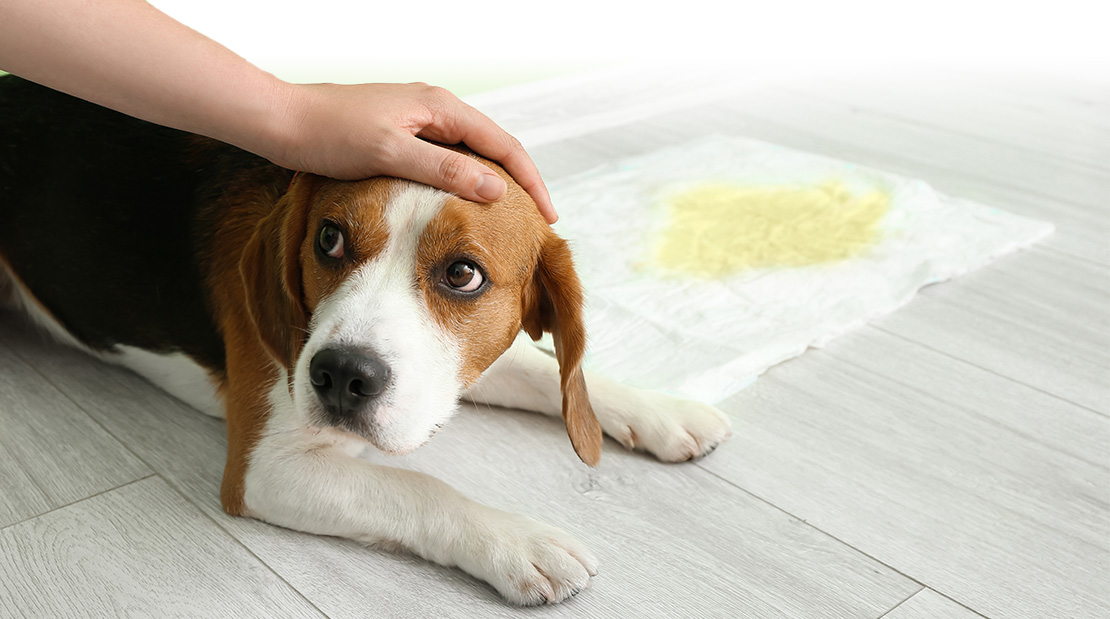
Urinary Incontinence in Dogs
If you’ve noticed your dog has urinary incontinence, it may be a behavioral issue or a symptom of several different health conditions. Here are some common causes and treatments.
What is Incontinence in Dogs?
First, it’s essential to define incontinence, abnormal micturition (urination) or abnormal urine streaming.
That can mean your dog is struggling with:
- Inability to urinate
- Significant increase in urination (polyuria)
- Exhibiting a lack of control over their urination
- Urinating in inappropriate places
- Straining to urinate
If you notice any of these symptoms, the first step to caring for your pet is to schedule an appointment with your veterinarian.
Behavioral Incontinence in Dogs
Sometimes, stressful or traumatic situations can cause behavioral incontinence in canines. If your dog suddenly changes urination habits, consider what’s happened in the last few weeks since you’ve seen this change.
- Did you move?
- Is there a new baby?
- Did you bring home a new pet?
New stress factors may cause the incontinence issue. The best way to deal with these stressors is to eliminate or minimize the stress factor for your pet. For instance, if a newborn cries throughout the night, you may need to move the dog to another room for proper rest.
If you’ve recently moved, be intentional about walking your dog around the new environment to get them used to it. Place their favorite things in the area they love most. Once your pet feels safe and calm, the urination issues will likely disappear on their own.
Incontinence in Puppies
For dogs that are under one year old and displaying issues with urinary incontinence– in addition to behavior– we must also consider congenital disorders such as an ectopic ureter or patent urachus.
Ectopic Ureter
An ectopic ureter is a rare congenital disease common in huskies, golden retrievers, labradors, and other breeds. An ectopic ureter occurs when a kidney’s ureter doesn’t connect properly to the bladder. Instead of connecting the kidney to the bladder, the ureters connect directly to the urethra or vagina of the dog. This shortcut interferes with the bladder’s ability to retain urine.
Symptoms of an ectopic ureter in puppies include frequent urination, discomfort, straining to urinate, blood in the urine, chronic urinary tract infections (UTIs), and certain skin conditions related to urine scalding.
Patent Urachus
Patent urachus is another rare congenital disability in dogs that occurs when the umbilical cord fails to seal after birth. With this disease, a canal from the bladder to the umbilicus is present, allowing urine to drain from the umbilicus and the bladder. Signs to watch for in your puppy include drainage around the umbilicus, abdominal pain, recurrent UTIs, straining to urinate, and urinary incontinence.
Surgery will be necessary for both of these diseases to correct the issue.
Incontinence in Middle Age Dogs
With middle-aged dogs, we often consider infections, inflammation, toxins, or drugs to be causes of incontinence.
Your vet might check if your dog:
- Is taking steroids (which can cause a significant increase in urination)
- Has eaten anything that could be toxic to the kidneys
- Is experiencing a UTI
- Has Bladder stones or urethral stones
- Experienced a recent injury
- Has an enlarged prostate
- Is drinking more water than usual (which may indicate psychogenic diabetes)
There are treatments available for all of these issues, and your middle-aged dog should likely be able to recover and return to normal micturition.
Incontinence in Older Dogs
For older dogs, your vet will probably check for hormonal issues, neuropathies, and even cancer. Bladder tumors can be a common cause of incontinence in older dogs, too. If your dog is starting to lose weight in addition to incontinence, it may indicate the possibility of diabetes mellitus.
Older dogs sometimes experience neuropathy, affecting their ability to hold in urine. And we regularly see older dogs dealing with bladder stones, vaginitis, and recurrent Urinary Tract Infections.
Everything starts with a physical exam and usually moves to a urinalysis and urine culture to rule out underlying causes. Sometimes, we correct the underlying cause, and the pet still exhibits clinical signs of incontinence. In those cases, we’ll look further into the issues with other modalities such as bloodwork, x-rays, ultrasound, and even CT scans. With incontinence, we don’t want to manage symptoms– but remedy the cause.
If your dog or cat is experiencing incontinence issues, schedule an appointment with the experienced veterinary care team at Cy-Fair Animal Hospital as soon as possible to ensure your pet receives the necessary care.

